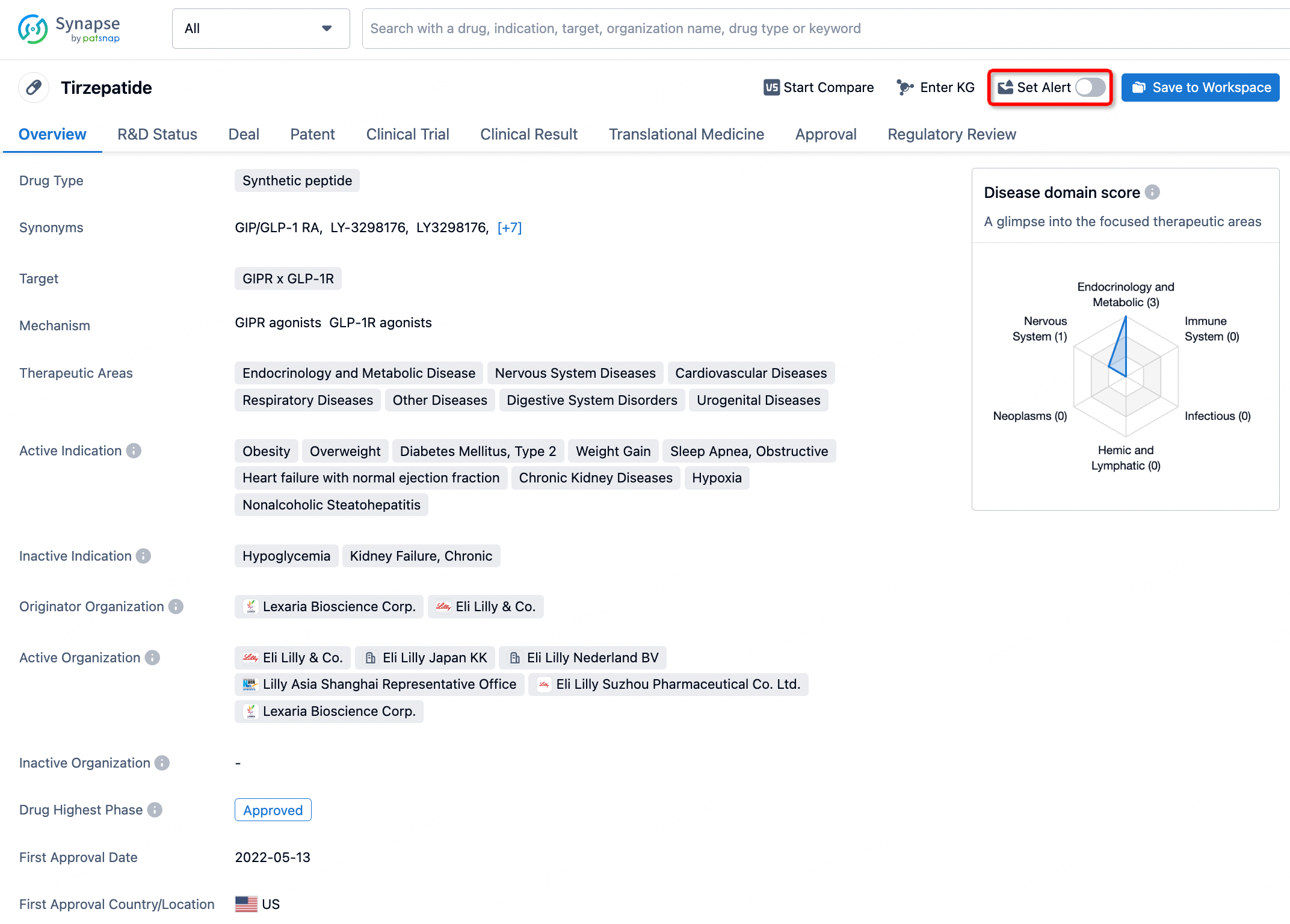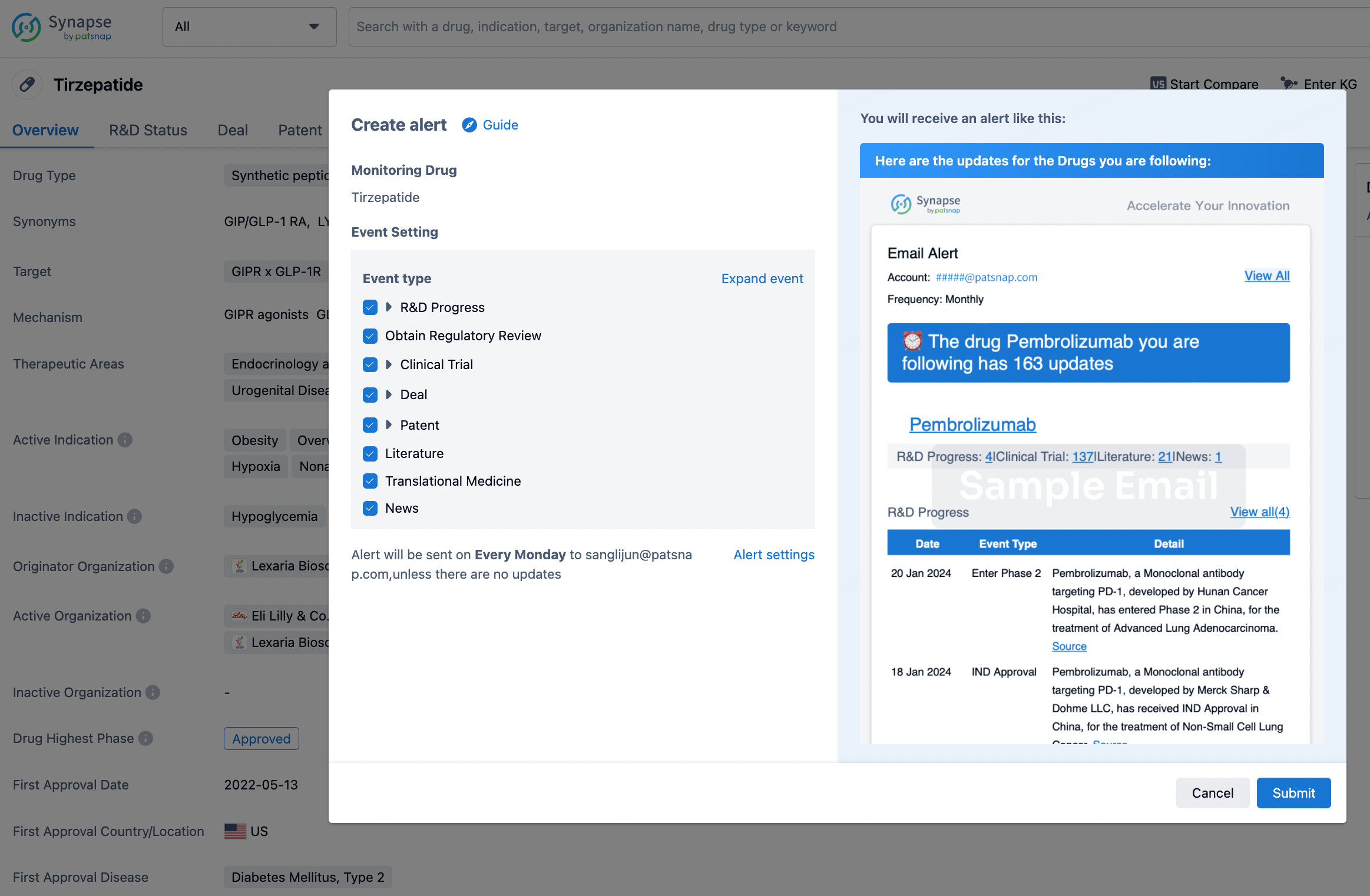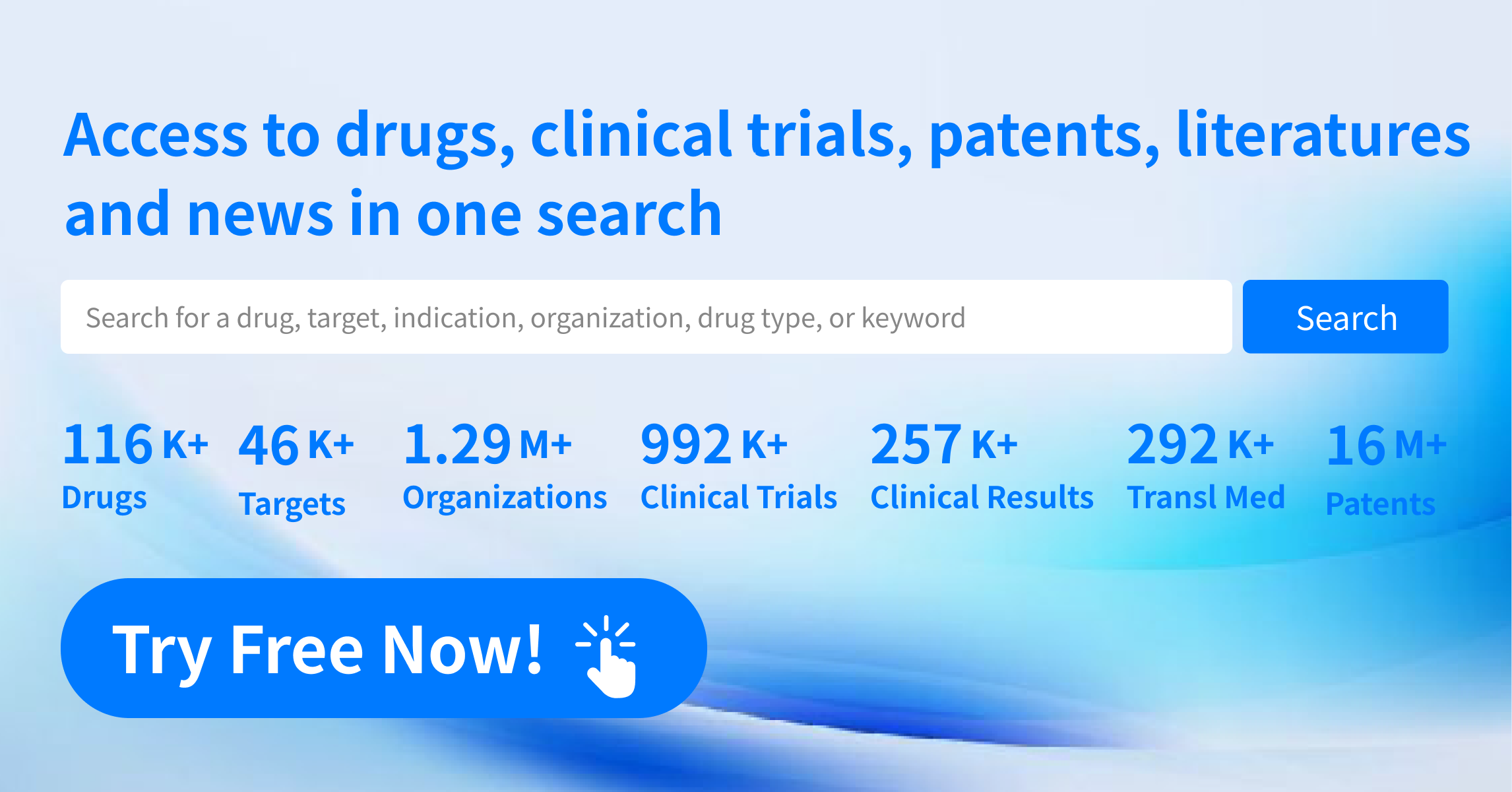Request Demo
What is Nadofaragene firadenovec-vncg used for?
14 June 2024
Nadofaragene firadenovec-vncg is a novel gene therapy that has garnered significant attention in the medical community for its potential to treat specific types of bladder cancer. Marketed under the trade name Adstiladrin, Nadofaragene firadenovec-vncg was developed as an innovative approach to address unmet medical needs in oncology. The drug specifically targets high-grade, non-muscle invasive bladder cancer (NMIBC), particularly in patients who are unresponsive to Bacillus Calmette-Guerin (BCG) therapy. This agent is a recombinant adenovirus vector-based gene therapy, developed through collaborative efforts among leading research institutions and pharmaceutical companies specializing in gene therapy and oncology. The drug has shown promising results in clinical trials, including Phase III studies, leading to its approval by the FDA and other regulatory agencies.
Nadofaragene firadenovec-vncg operates via a unique mechanism of action that distinguishes it from traditional chemotherapy and immunotherapy options. The drug utilizes a non-replicating adenovirus vector to deliver the human interferon alfa-2b gene directly to the bladder's urothelial cells. Once inside the cells, the gene is expressed to produce high levels of interferon alfa-2b, a potent cytokine known for its anti-tumor activity. This cytokine works by enhancing the body's immune response against cancer cells and exerting direct anti-proliferative effects on the malignant cells within the bladder. Essentially, Nadofaragene firadenovec-vncg transforms the bladder into a bioactive “factory” for interferon production, creating a hostile environment for cancer cells and reducing tumor growth and recurrence.
The administration of Nadofaragene firadenovec-vncg is relatively straightforward and is designed to be patient-friendly. The drug is delivered directly into the bladder through a catheter in a process known as intravesical administration. This method ensures that the therapeutic agent is concentrated at the site of the tumor, maximizing efficacy while minimizing systemic exposure and associated side effects. Typically, the treatment involves a single instillation every three months, making it less burdensome compared to more frequent administration schedules required by other therapies. The onset of therapeutic action is quite rapid, with patients often experiencing clinical benefits within weeks of the first dose. It's essential for the drug to be administered in a clinical setting by healthcare professionals experienced in bladder cancer treatments to ensure proper technique and patient safety.
Like all medical treatments, Nadofaragene firadenovec-vncg comes with a profile of potential side effects and contraindications that need to be carefully considered. Common side effects include localized reactions such as bladder irritation, urinary frequency, and discomfort during urination. Some patients may experience flu-like symptoms, including fever, chills, and fatigue, which are generally mild to moderate and transient in nature. Serious adverse events are rare but can include severe urinary tract infections and systemic inflammatory responses. Contraindications for the use of Nadofaragene firadenovec-vncg include hypersensitivity to interferon or any components of the adenoviral vector, as well as patients with active urinary tract infections or significant bladder dysfunction. It's crucial for healthcare providers to conduct a thorough medical evaluation and consider these factors before initiating treatment.
Interactions with other medications are an important consideration when managing treatment with Nadofaragene firadenovec-vncg. While the intravesical delivery method reduces the likelihood of systemic drug interactions, it is still possible for other medications to influence the therapy's efficacy and safety profile. For instance, immunosuppressive drugs, such as corticosteroids or chemotherapy agents, can potentially diminish the therapeutic effects of interferon alfa-2b by dampening the immune response. Conversely, combining Nadofaragene firadenovec-vncg with other immunostimulatory agents could amplify immune-related side effects. It is also wise to avoid concurrent use of other intravesical treatments unless explicitly recommended by a healthcare provider. Patients should always inform their healthcare team of all medications they are taking, including over-the-counter drugs and herbal supplements, to prevent any adverse interactions and ensure the optimal outcome of their bladder cancer treatment.
In summary, Nadofaragene firadenovec-vncg represents a significant advancement in the treatment of high-grade, non-muscle invasive bladder cancer, particularly for patients who have not responded to BCG therapy. Its innovative mechanism of action, involving direct gene transfer and localized production of interferon alfa-2b, offers a promising alternative to traditional treatments. The intravesical administration method is designed to maximize efficacy at the tumor site while minimizing systemic exposure. Although the drug comes with potential side effects and contraindications, careful patient selection and monitoring can help mitigate these risks. Understanding the possible interactions with other drugs further aids in managing treatment and optimizing patient outcomes. As research and clinical experience with Nadofaragene firadenovec-vncg continue to grow, it holds the potential to significantly improve the management and prognosis of bladder cancer patients.
Nadofaragene firadenovec-vncg operates via a unique mechanism of action that distinguishes it from traditional chemotherapy and immunotherapy options. The drug utilizes a non-replicating adenovirus vector to deliver the human interferon alfa-2b gene directly to the bladder's urothelial cells. Once inside the cells, the gene is expressed to produce high levels of interferon alfa-2b, a potent cytokine known for its anti-tumor activity. This cytokine works by enhancing the body's immune response against cancer cells and exerting direct anti-proliferative effects on the malignant cells within the bladder. Essentially, Nadofaragene firadenovec-vncg transforms the bladder into a bioactive “factory” for interferon production, creating a hostile environment for cancer cells and reducing tumor growth and recurrence.
The administration of Nadofaragene firadenovec-vncg is relatively straightforward and is designed to be patient-friendly. The drug is delivered directly into the bladder through a catheter in a process known as intravesical administration. This method ensures that the therapeutic agent is concentrated at the site of the tumor, maximizing efficacy while minimizing systemic exposure and associated side effects. Typically, the treatment involves a single instillation every three months, making it less burdensome compared to more frequent administration schedules required by other therapies. The onset of therapeutic action is quite rapid, with patients often experiencing clinical benefits within weeks of the first dose. It's essential for the drug to be administered in a clinical setting by healthcare professionals experienced in bladder cancer treatments to ensure proper technique and patient safety.
Like all medical treatments, Nadofaragene firadenovec-vncg comes with a profile of potential side effects and contraindications that need to be carefully considered. Common side effects include localized reactions such as bladder irritation, urinary frequency, and discomfort during urination. Some patients may experience flu-like symptoms, including fever, chills, and fatigue, which are generally mild to moderate and transient in nature. Serious adverse events are rare but can include severe urinary tract infections and systemic inflammatory responses. Contraindications for the use of Nadofaragene firadenovec-vncg include hypersensitivity to interferon or any components of the adenoviral vector, as well as patients with active urinary tract infections or significant bladder dysfunction. It's crucial for healthcare providers to conduct a thorough medical evaluation and consider these factors before initiating treatment.
Interactions with other medications are an important consideration when managing treatment with Nadofaragene firadenovec-vncg. While the intravesical delivery method reduces the likelihood of systemic drug interactions, it is still possible for other medications to influence the therapy's efficacy and safety profile. For instance, immunosuppressive drugs, such as corticosteroids or chemotherapy agents, can potentially diminish the therapeutic effects of interferon alfa-2b by dampening the immune response. Conversely, combining Nadofaragene firadenovec-vncg with other immunostimulatory agents could amplify immune-related side effects. It is also wise to avoid concurrent use of other intravesical treatments unless explicitly recommended by a healthcare provider. Patients should always inform their healthcare team of all medications they are taking, including over-the-counter drugs and herbal supplements, to prevent any adverse interactions and ensure the optimal outcome of their bladder cancer treatment.
In summary, Nadofaragene firadenovec-vncg represents a significant advancement in the treatment of high-grade, non-muscle invasive bladder cancer, particularly for patients who have not responded to BCG therapy. Its innovative mechanism of action, involving direct gene transfer and localized production of interferon alfa-2b, offers a promising alternative to traditional treatments. The intravesical administration method is designed to maximize efficacy at the tumor site while minimizing systemic exposure. Although the drug comes with potential side effects and contraindications, careful patient selection and monitoring can help mitigate these risks. Understanding the possible interactions with other drugs further aids in managing treatment and optimizing patient outcomes. As research and clinical experience with Nadofaragene firadenovec-vncg continue to grow, it holds the potential to significantly improve the management and prognosis of bladder cancer patients.
How to obtain the latest development progress of all drugs?
In the Synapse database, you can stay updated on the latest research and development advances of all drugs. This service is accessible anytime and anywhere, with updates available daily or weekly. Use the "Set Alert" function to stay informed. Click on the image below to embark on a brand new journey of drug discovery!
AI Agents Built for Biopharma Breakthroughs
Accelerate discovery. Empower decisions. Transform outcomes.
Get started for free today!
Accelerate Strategic R&D decision making with Synapse, PatSnap’s AI-powered Connected Innovation Intelligence Platform Built for Life Sciences Professionals.
Start your data trial now!
Synapse data is also accessible to external entities via APIs or data packages. Empower better decisions with the latest in pharmaceutical intelligence.


